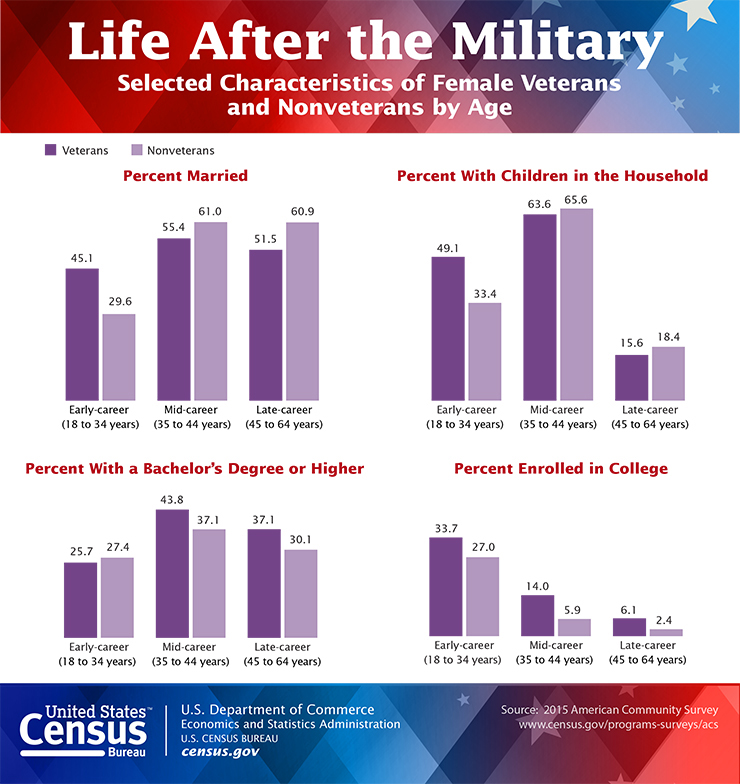
September 7, 2017 - A new report on the characteristics of female veterans by the U.S. Census Bureau shows that early-career aged female veterans (18 to 34 years old) were more likely to be employed, married and have a child in their home than early-career aged female nonveterans.
This report, which uses 2015 American Community Survey data, takes three different age snapshots, early-career (ages 18 to 34), mid-career (ages 35 to 44) and late-career (ages 45 to 64), as career proxies to determine if female veterans are different from nonveterans as they transition from military to civilian life throughout their working ages.
“This report shows some key differences between female veterans and nonveterans in the various stages of their lives,” said Daphne Lofquist, a demographer in the Social, Economic and Housing Statistics Division. “The differences are most prominent for those in the early-career age group. As they age, female veterans and nonveterans become more similar.”
A few notable differences for early-career veteran and nonveteran women:
- Early-career aged veteran women had higher rates of being married (45.1 percent) than nonveteran women in the same age group (29.6 percent).
- Early-career veteran women had a higher percentage of having a child under 18 years old living in the household (49.1 percent compared to 33.4 percent of nonveteran women).
- The median age of early-career veteran women was older than their nonveteran counterparts (30 years compared with 26 years).
- Employed early-career veteran women had higher rates of working full-time, year-round, 68.7 percent, compared to 54.9 percent for their counterparts.
- Early-career veteran women had higher rates of working in the government, 37.1 percent, compared to 11.5 of their counterparts.
Education also differed between female veterans and nonveterans. Early-career veterans were less likely than early-career nonveterans to have completed a college degree. However, the reverse is true of mid- and late-career women, as a higher percentage of veterans had a completed a bachelor’s degree or higher than nonveterans in these age groups. A higher percentage of female veterans were also enrolled in college compared with female nonveterans, across all age groups.
Overall, employed female veterans were more likely to work full time, year-round (75.1 percent versus 64.6 percent); work in the government (34.8 percent versus 16.0 percent); and, for those employed full-time, year-round, have higher median earnings ($45,509 versus $39,927) than female nonveterans.
For more information on female veterans, check out the graphic and Random Samplings Blog, Women Responsible for the Increasing Number of “Vetrepreneurs,” which features economic data from the 2014 Annual Survey of Entrepreneurs.
For more information about veterans of the U.S. armed forces, go to the Census Bureau’s website on veteran statistics at <www.census.gov/topics/population/veterans.html>.
Source: U.S. Census Bureau








